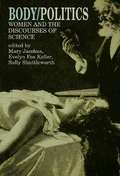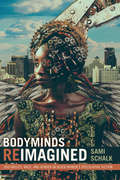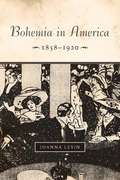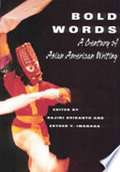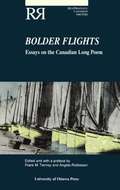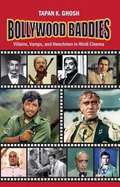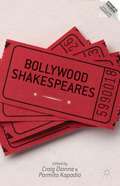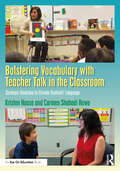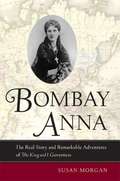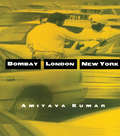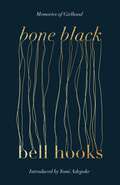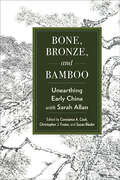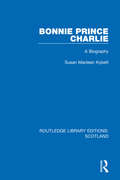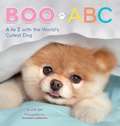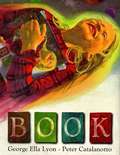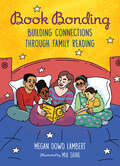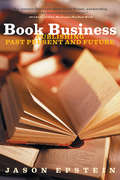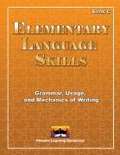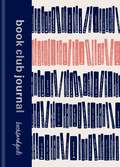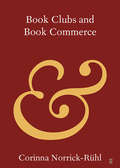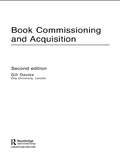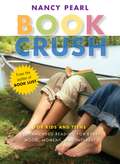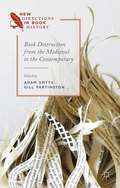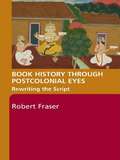- Table View
- List View
Body/Politics: Women and the Discourses of Science
by Sally Shuttleworth Mary Jacobus Evelyn Fox KellerBody/Politics demonstrates how many of the controversies in modern science involve or invoke the feminine body as their battleground. This groundbreaking collection addresses such scientific issues as artificial fertilization, the "crisis" in childbirth management,and the medical invention of "female" maladies and the debates surrounding them. In the process it makes an important attempt to remedy the traditional division between science and non-science by focusing on the interconnection of literary, social, and scientific discourses concerning the female body. The editors have brought together noted feminist scholars and critics from various fields. Contributers include Susan Bordo, Mary Ann Doane, Donna Haraway, Emily Martin, Mary Poovey and Paula A. Treichler.
Bodyminds Reimagined: (Dis)ability, Race, and Gender in Black Women's Speculative Fiction
by Sami SchalkIn Bodyminds Reimagined Sami Schalk traces how black women's speculative fiction complicates the understanding of bodyminds—the intertwinement of the mental and the physical—in the context of race, gender, and (dis)ability. Bridging black feminist theory with disability studies, Schalk demonstrates that this genre's political potential lies in the authors' creation of bodyminds that transcend reality's limitations. She reads (dis)ability in neo-slave narratives by Octavia Butler (Kindred) and Phyllis Alesia Perry (Stigmata) not only as representing the literal injuries suffered under slavery, but also as a metaphor for the legacy of racial violence. The fantasy worlds in works by N. K. Jemisin, Shawntelle Madison, and Nalo Hopkinson—where werewolves have obsessive-compulsive-disorder and blind demons can see magic—destabilize social categories and definitions of the human, calling into question the very nature of identity. In these texts, as well as in Butler’s Parable series, able-mindedness and able-bodiedness are socially constructed and upheld through racial and gendered norms. Outlining (dis)ability's centrality to speculative fiction, Schalk shows how these works open new social possibilities while changing conceptualizations of identity and oppression through nonrealist contexts.
Bohemia in America, 1858-1920
by Joanna LevinBohemia in America, 1858-1920explores the construction and emergence of "Bohemia" in American literature and culture. Simultaneously a literary trope, a cultural nexus, and a socio-economic landscape,la vie bohèmetraveled to the United States from the Parisian Latin Quarter in the 1850s. At first the province of small artistic coteries, Bohemia soon inspired a popular vogue, embodied in restaurants, clubs, neighborhoods, novels, poems, and dramatic performances across the country. Levin's study followsla vie bohèmefrom its earliest expressions in the U. S. until its explosion in Greenwich Village in the 1910s. Although Bohemia was everywhere in nineteenth- and twentieth-century American culture, it has received relatively little scholarly attention. Bohemia in America, 1858-1920fills this critical void, discovering and exploring the many textual and geographic spaces in which Bohemia was conjured. Joanna Levin not only provides access to a neglected cultural phenomenon but also to a new and compelling way of charting the development of American literature and culture.
Bold Words: A Century of Asian American Writing
by Rajini SrikanthA century of Asian American writing has generated a forceful cascade of "bold words." This anthology covers writings by Asian Americans in all genres, from the early twentieth century to the present. Some sixty authors of Chinese, Filipino, Japanese, Korean, South Asian, and Southeast Asian American origin are represented, with an equal split between male and female writers. The collection is divided into four sections-memoir, fiction, poetry, and drama-prefaced by an introductory essay from a well-known practitioner of that genre: Meena Alexander on memoir, Gary Pak on fiction, Eileen Tabios on poetry, and Roberta Uno on drama. The selections depict the complex realities and wide range of experiences of Asians in the United States. They illuminate the writers' creative responses to issues as diverse as resistance, aesthetics, biculturalism, sexuality, gender relations, racism, war, diaspora, and family. Rajini Srikanth teaches at the University of Massachusetts, Boston. She is the coeditor of the award-winning anthology Contours of the Heart: South Asians Map North America and the collection A Part, Yet Apart: South Asians in Asian America. Esther Y. Iwanaga teaches Asian American literature and literature-based writing courses at Wellesley College and the University of Massachusetts, Boston.
Bolder Flights: Essays on the Canadian Long Poem
by Frank M. Tierney Angela RobbesonA growing number of literary historians and critics now recognize the contemporary long poem as a distinctively Canadian genre. This collection of essays leads the reader to a deeper understanding of Canadian literary cultures in terms of their local intimacies and idiosyncrasies as well as in their national contexts.
Bollywood Baddies
by Tapan K GhoshBollywood Baddies is the first-of-its-kind book-length narrative of villainy in Hindi films. It discusses villains, vamps, and henchmen of Bollywood cinema, and also the actors who essayed such characters over the decades. The author discusses not just villains but also the evaluation of villainous characters vis-à-vis sociopolitical conditions in the country. The narrative begins with Ashok Kumar's negative role in Kismet as early as 1943, and goes up to the Agneepath remake (2012), where Sanjay Dutt plays Kancha Cheena, earlier essayed by Danny Denzongpa in the original. In between, it discusses all major villains, from Lala Sukhiram (Mother India) to Gabbar (Sholay) to "Lion" Ajit (Kalicharan) to Mogambo (Mr. India), and many others. While keeping villains in the focus, it also discusses popular henchmen and vamps, like M B Shetty, Sharat Saxena, Nadira, Bindu, Helen, among others, to understand the dimension of the villains' empire. After all, it's our villains who make our protagonist the hero we all admire. An engrossing read, this book is for every film buff.
Bollywood Shakespeares
by Craig Dionne Parmita KapadiaHere, essays use the latest theories in postcolonialism, globalization, and post-nationalism to explore how world cinema and theater respond to Bollywood's representation of Shakespeare. In this collection, Shakespeare is both part of an elite Western tradition and a window into a vibrant post-national identity founded by a global consumer culture.
Bolstering Vocabulary with Teacher Talk in the Classroom: Strategic Modeling to Elevate Students’ Language
by Kristen Haase Carmen Shahadi RoweThis practical guide introduces "Teacher Talk," an easy-to-use tool for teachers to help improve elementary students’ vocabulary. When students are exposed to extensive vocabularies, they are better prepared to build their receptive and productive language and succeed academically. Through many inviting examples and real-world guidance, Rowe and Haase explain how to be reflective and intentional about the language you use and how to use elevated or substitutionary language to model different registers of speech for elementary students. The various "Teacher Talk" strategies in this book cover key topics, including disciplinary vocabulary, modelling academic discourse, addressing state and national standards, and meeting individual student needs across grades K–6. With many charts, activities, and tools that are ready for use, this book equips teachers with many methods for bolstering students’ academic language in the classroom and beyond.
Bombay Anna: The Real Story and Remarkable Adventures of the King and I Governess
by Susan MorganThis biography shows, the real life of Anna Leonowens was far more fascinating than the beloved story of the Victorian governess who went to work for the King of Siam.
Bombay--London--New York (Routledge Studies in Health and Social Welfare)
by Amitava KumarFirst published in 2003. Routledge is an imprint of Taylor & Francis, an informa company.
Bone Black: Memories of Girlhood
by bell hooksOne of bell hooks' foundational works introduced to the UK for the first time.'With the emotion of poetry, the narrative of a novel, and the truth of experience, bell hooks weaves a girlhood memoir you won't be able to put down―or forget. Bone Black takes us into the cave of self-creation' Gloria SteinemStitching together the threads of her girlhood memories, bell hooks shows us one strong-spirited child's journey toward becoming the pioneering writer we know. Along the way, hooks sheds light on the vulnerability of children, the special unfurling of female creativity and the imbalance of a society that confers marriage's joys upon men and its silences on women.In a world where daughters and fathers are strangers under the same roof, and crying children are often given something to cry about, hooks uncovers the solace to be found in solitude, the comfort to be had in the good company of books.Bone Black allows us to bear witness to the awakening of a legendary author's awareness that writing is her most vital breath.
Bone, Bronze, and Bamboo: Unearthing Early China with Sarah Allan (SUNY series in Chinese Philosophy and Culture)
by Constance A. Cook; Christopher J. Foster; Susan BladerBone, Bronze, and Bamboo explores the tremendous wealth of newly unearthed artifacts and manuscripts that have been revolutionizing the study of early China. Leading scholars from China and abroad lend their expertise in archaeology, art history, paleography, intellectual history, and many other disciplines to show how these fascinating finds change our understanding of China's past. Organized in a chronological progression from the Shang to Han periods, and treating bone, bronze, and bamboo-strip artifacts in turn, the book treats a wide breadth of topics, from the status of owls in Shang religion to the Zhou court's economic interest in managing salt resources, and from the conceptual evolution of de 德 in Spring and Autumn covenants to the interplay between materiality and text in Han scribal primers. Bone, Bronze, and Bamboo exemplifies the exciting energy and sense of discovery inspired by these sources in recent years, while surveying the latest debates and developments shaping early China as a field.
Bonnie Prince Charlie: A Biography (Routledge Library Editions: Scotland #14)
by Susan Maclean KybettOriginally published in 1988, this biography was the result of 15 years research, including unearthing 70,000 letters and documents among the Stuart Papers which had hitherto lain largely untapped. Written in many different languages, some were damaged, written in code, or unsigned and undated. Deciphering them therefore made it possible to gain a new level of insight into Bonnie Prince Charlie as a man, his relationship with his exiled father, the role played by France and the true nature of the events leading up to the bloody campaign of 1745 in which he attempted to win back the throne of his ancestors.
Boo ABC
by J. H. LeeA is for Adorable, B is for Boo! The world's cutest dog takes on the ABCs, and his adventures are more precious than ever. Boo and his best friend Buddy are featured in their favorite situations and places alongside the letters of the alphabet. The ABCs have never been so furry--and fun!
Book
by George Ella LyonA loved book lifts you -- comforts, excites, entices. Book, in words and paintings, captures the feeling of opening to page one -- for the first or the fiftieth time - and entering the worlds of drama, imagination, and fun promised beyond it. A girl in red flannel pj's reaches toward a panel in the night sky. The panel, one of four, bears a B. Light floods the girl's face, all anticipation, for she is all readers.And then she is inside, inside the B-O-O-K, words streaming toward her, beckoning, circling her, music in their meaning and their sound. A castle, a cave - its walls dancing with wild ponies, one of which joins the girl on her journey -- these are passing wonders on the way to the source.
Book Bonding: Building Connections Through Family Reading
by Megan Dowd LambertA collection of essays about family, reading, and bonding with others through books. From children&’s literature educator and children&’s book author Megan Dowd Lambert.This poignant, funny, and touching essay collection invites readers to consider how they bond with children, other family, friends, and students through shared reading. Divided into 4 sections organized around themes of parenting, adoption, race, and healing, this 21-essay collection with its joyous and colorful illustrations is perfect gift for parents, grandparents, librarians, educators, and anyone who spends time with children or reading together with others. The author's experience as an educator and as a parent in a blended family that includes seven children of various racial backgrounds (four of whom came home through adoption) adds depth and breadth to her expertise about how people read and respond to books. "I grew up with a mother who loved to read, and what a sustaining gift that has been to me. If you are holding this book, it&’s a good bet that you love to read, too. Read on, and let Megan show you how to make your love for books and your love for the children in your life add up to something special."--Roger Sutton, Editor Emeritus, The Horn Book, Inc., from Book Bonding's foreword
Book Business: Publishing Past, Present, and Future
by Jason Epstein"An irresistible book about Grub Street, authorship and the literary marketplace."--Washington Post Book World Jason Epstein has led arguably the most creative career in book publishing during the past half-century. He founded Anchor Books and launched the quality paperback revolution, cofounded the New York Review of Books, and created of the Library of America, the prestigious publisher of American classics, and The Reader's Catalog, the precursor of online bookselling. In this short book he discusses the severe crisis facing the book business today--a crisis that affects writers and readers as well as publishers--and looks ahead to the radically transformed industry that will revolutionize the idea of the book as profoundly as the introduction of movable type did five centuries ago.
Book C Elementary Language Skills: Grammar, Usage, and Mechanics of Writing
by Phoenix Learning Resources StaffElementary Language Skills Textbook
Book Club Journal
by Sanne VliegenthartBooks connect us: we rave about our favourites to anyone who will listen, pass on our well-thumbed copies to friends and get together in book clubs to chat through our opinionsThis ebook will allow you to gather your thoughts on the books you have read, with 50 templates to download and fill in. You will also find advice on how to organize a successful book club, pick your discussion topics and make the most of your reading time, plus 200 book recommendations arranged into 20 themed reading lists, carefully curated by Sanne Vliegenthart, book reviewer and creator of hugely popular book videos at Books and Quills.Find Sanne on Twitter, Instagram and Youtube @booksandquillsThis ebook is not an exact replica of the physical book. All templates from the book are available as downloadable pdfs to print and fill in.
Book Club Journal
by Sanne VliegenthartBooks connect us: we rave about our favourites to anyone who will listen, pass on our well-thumbed copies to friends and get together in book clubs to chat through our opinionsThis ebook will allow you to gather your thoughts on the books you have read, with 50 templates to download and fill in. You will also find advice on how to organize a successful book club, pick your discussion topics and make the most of your reading time, plus 200 book recommendations arranged into 20 themed reading lists, carefully curated by Sanne Vliegenthart, book reviewer and creator of hugely popular book videos at Books and Quills.Find Sanne on Twitter, Instagram and Youtube @booksandquillsThis ebook is not an exact replica of the physical book. All templates from the book are available as downloadable pdfs to print and fill in.
Book Clubs and Book Commerce: Volume 1 (Elements in Publishing and Book Culture)
by Corinna Norrick-RühlIn the 20th century, cumulative millions of readers received books by mail from clubs like the Book-of-the-Month Club, the Book Society or BertelsmannClub. This Element offers an introduction to book clubs as a distribution channel and cultural phenomenon, and shows that book clubs and book commerce are linked inextricably. It argues that a global perspective is necessary to understand the cultural and economic impact of book clubs in the 20th and into the 21st century. It also explores central reasons for book club membership, condensing them into four succinct categories: convenience, community, concession and, most importantly, curation. This title is also available as Open Access on Cambridge Core.
Book Commissioning and Acquisition
by Gill DaviesSince its first publication, this essential guide to book commissioning has established itself as the one and only 'must-read' for any successful editor, and the core training text used both within publishing houses and on publishing courses worldwide.In this new edition, Davies concentrates on the essential skills of commissioning, as well as other editorial challenges such as handling new lists following mergers and takeovers, and the demands of digital technology. New case-studies have been added which illustrate the commercial and practical problems that editors must address in today's complex and demanding marketplace.This book remains the one text that editors must have by their side throughout their careers.
Book Crush: For Kids and Teens - Recommended Reading for Every Mood, Moment and Interest
by Nancy PearlFrom picture books to chapter books, YA fiction and nonfiction, Nancy Pearl has developed more thematic lists of books to enjoy. The Book Lust audience is committed to reading, and here is a smart and entertaining tool for picking the best books for kids. Divided into three sections--Easy Books, Middle-Grade Readers, and Young Adult--Nancy Pearl makes wonderful reading connections by theme, setting, voice, and ideas. For horse lovers, she reminds us of the mainstays in the category (Black Beauty, Misty of Chincoteague, etc.) but then in a creative twist connects Mr. Revere and I to the list. In a list called Chapter One, she answers the proverbial question: which chapters books are the most compelling for kids who are now ready to move beyond picture books. And who says picture books aren't deep? Recommended Folk Tales sort out many of life's dilemmas and issues of good and bad; a selection of picture books on Death and Dying introduces this topic with sensitivity; and You've Got a Friend offers up books for early readers that show the complexities and the pleasures of relating to others. Parents, teachers, and librarians are often puzzled by the unending choices for reading material for young people. It starts when the kids are toddler and doesn't end until high-school graduation. What's good, what's trash, what's going to hold their interest? Nancy Pearl, America's favorite librarian, points the way in Book Crush.
Book Destruction from the Medieval to the Contemporary
by Gill PartingtonThis rich and varied collection of essays by scholars and interviews with artists approaches the fraught topic of book destruction from a new angle, setting out an alternative history of the cutting, burning, pulping, defacing and tearing of books from the medieval period to our own age.
Book History Through Postcolonial Eyes: Rewriting the Script
by Robert FraserThis surprising study draws together the disparate fields of postcolonial theory and book history in a challenging and illuminating way. Robert Fraser proposes that we now look beyond the traditional methods of the Anglo-European bibliographic paradigm, and learn to appreciate instead the diversity of shapes that verbal expression has assumed across different societies. This change of attitude will encourage students and researchers to question developmentally conceived models of communication, and move instead to a re-formulation of just what is meant by a book, an author, a text. Fraser illustrates his combined approach with comparative case studies of print, script and speech cultures in South Asia and Africa, before panning out to examine conflicts and paradoxes arising in parallel contexts. The re-orientation of approach and the freshness of view offered by this volume will foster understanding and creative collaboration between scholars of different outlooks, while offering a radical critique to those identified in its concluding section as purveyors of global literary power.
